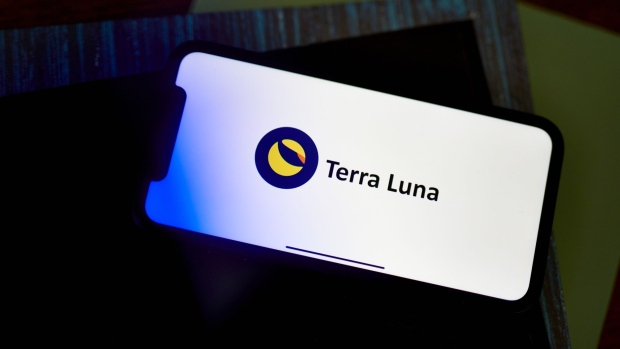May 31, 2022
‘Pure Gambling’ Prompts Wild Swings in New Luna Cryptocurrency
, Bloomberg News

(Bloomberg) -- Terra’s new Luna token is taking holders on a wild ride just days after being distributed to investors who saw the value of their cryptocurrencies tied to the failed blockchain destroyed.
Various trading platforms showed differing prices after the tokens were awarded on Saturday in what’s referred to in the crypto industry as an airdrop. Kraken data show that the price opened at around $17, and swung between $30 and $4.80. OKX listed an opening price of $1, with extremes of $20 and $5. Luna 2.0, as the new token is known, was up about 30% to around $9 on Tuesday, according to pricing data from from TradingView and Kraken.
Veteran observers pointed out that while volatility is a fixture in crypto, the extreme moves stand out. Speculators are likely seeking to book quick gains on the moves higher, while previous holders of the failed TerraUSD (UST) stablecoin and Luna tokens are trying to recoup losses of around $40 billion.
“This is pure gambling like crypto has never seen,” said Fadi Aboualfa, head of research at crypto prime brokerage Copper.
Even though thousands of, if not millions of, investors saw the value of their crypto holdings associated with the original Terra blockchain wiped out earlier this month, many crypto exchanges started supporting trading Luna 2.0 tokens. Binance, the largest crypto trading platform, listed it Tuesday.
“For users who hold Luna 1.0 on the platform, the airdrop of Luna 2.0 can ideally assist in making up for the losses during previous incidents,” a representative of crypto exchange Huobi wrote in an email response on Huobi’s support of listing Luna 2.0.
Analysts in general remain bearish on the new Terra blockchain created by Terraform Labs, who is also responsible for the original Terra blockchain.
“This initial volatility just shows to me that Luna 2.0 is now a speculative asset, and will likely trade on narrative until they can regain the trust of builders to bring fundamental value to the new ecosystem,” said Thomas Dunleavy, senior crypto research analyst at digital-asset data firm Messari. “I really, really doubt they can do that with so many other great, and well-funded alternatives out there.”
Under a measure approved last week by the Terra community, the original Terra blockchain was split off and is known now as Terra Classic, while Luna, which plunged close to zero this month, was renamed Luna Classic with the ticker LUNC. The new Terra blockchain does not include stablecoins. The collapse of Terra’s algorithmic UST stablecoin triggered a broader meltdown in crypto earlier this month, which saw billions of dollars vanished in just a few days.
“One of the most important things about crypto is the brand or marketing and community,” Aboualfa said. “Terra has burned its community, and brand is tarnished. Whatever they do here is going to be pointless.”
Terra’s official Twitter account said earlier that there’s an issue with the token airdrop, with some investors receiving less Luna 2.0 than expected, adding that the team is “actively working on a solution.”
John Kramer, director of trading at crypto market maker GSR, pointed out that the new Luna token is still relatively “illiquid,” and some investors are still holding their new Luna 2.0 tokens.
“The remaining holders likely view the tokens as a call option on the potential success of the rebooted network, refusing to sell for pennies on the dollar compared to their prior value,” Kramer said.
©2022 Bloomberg L.P.





